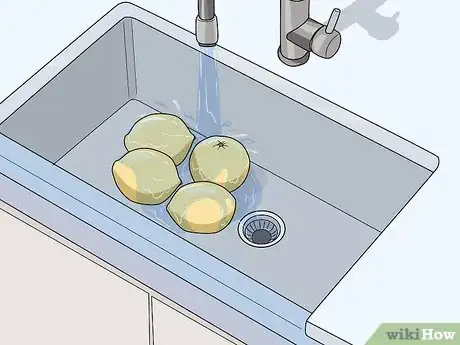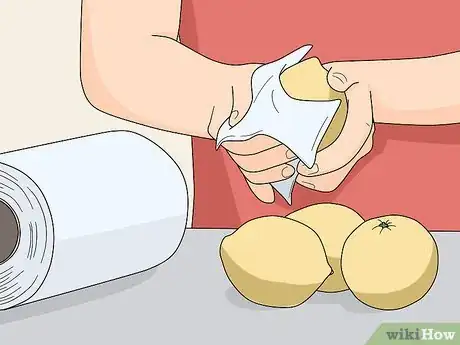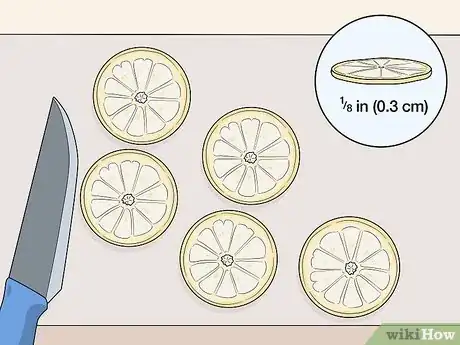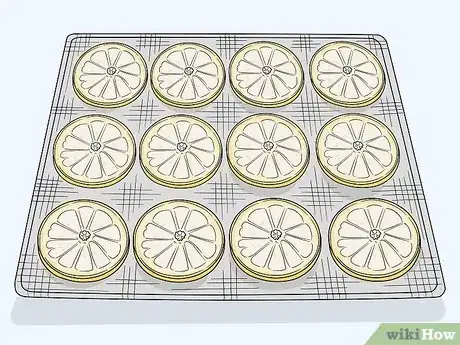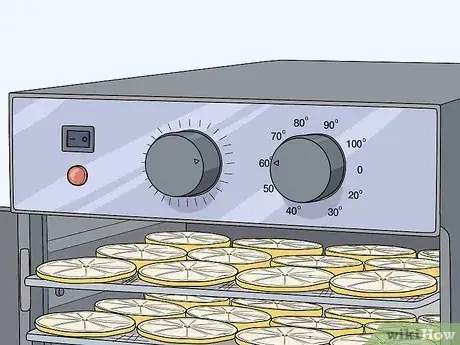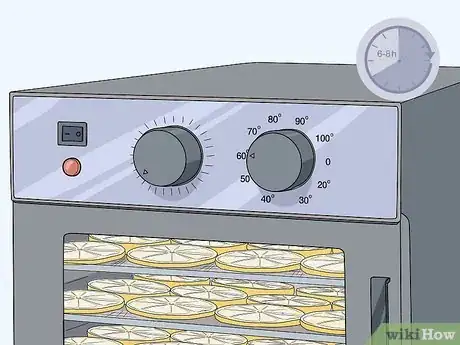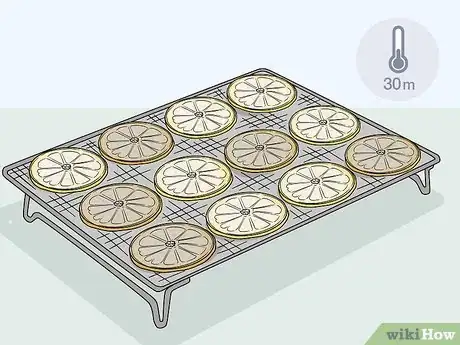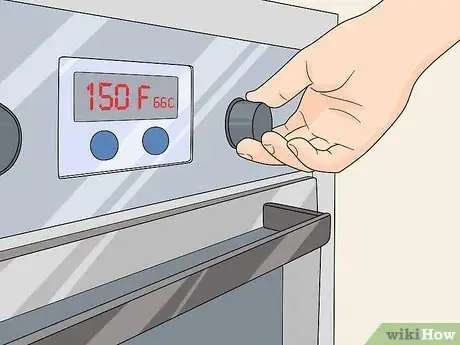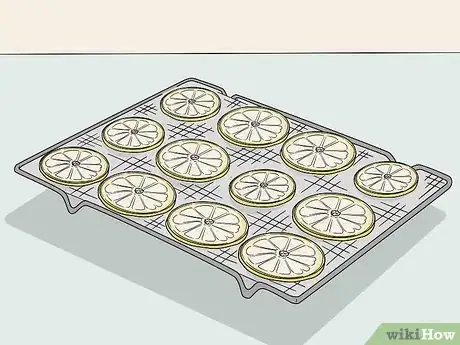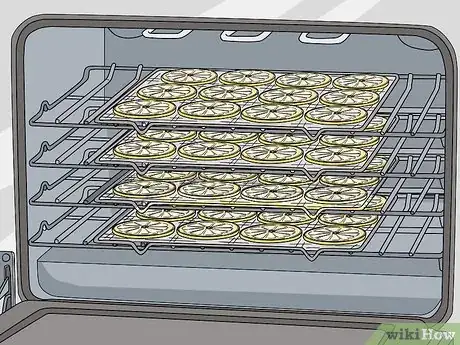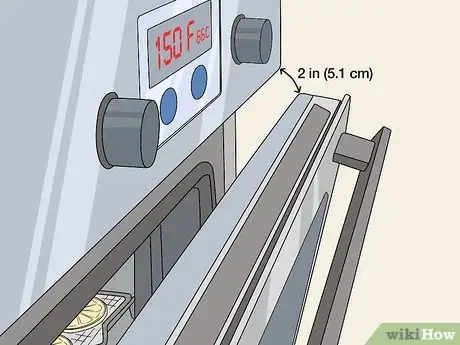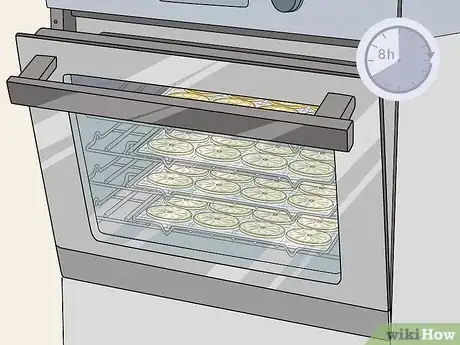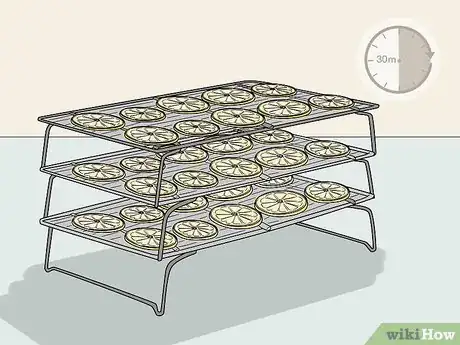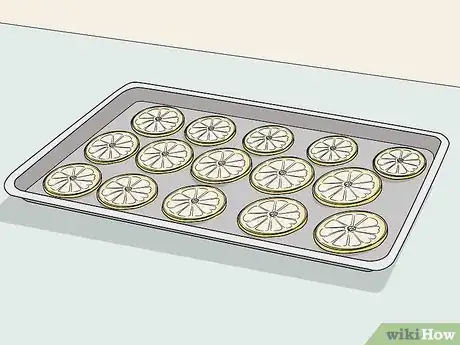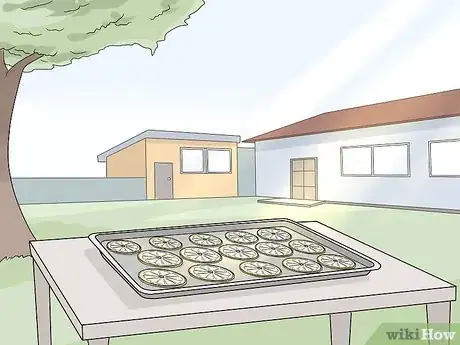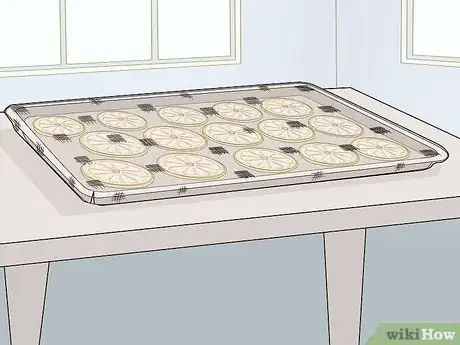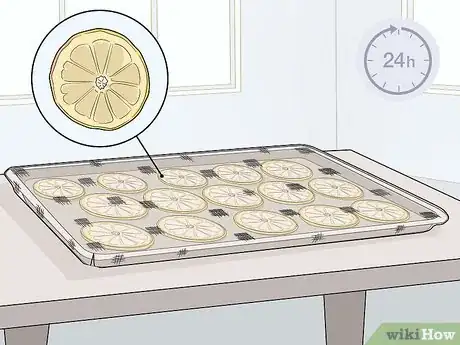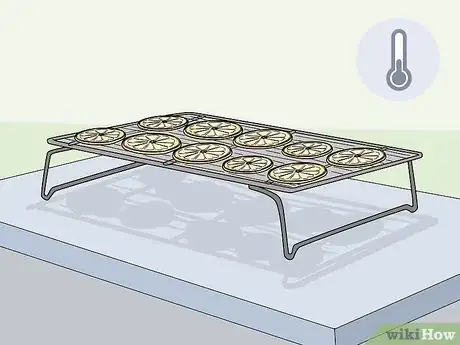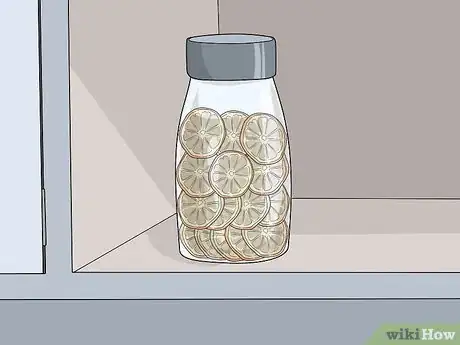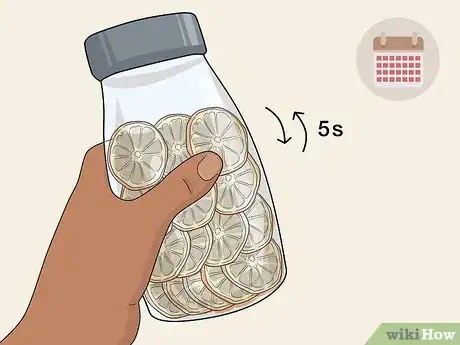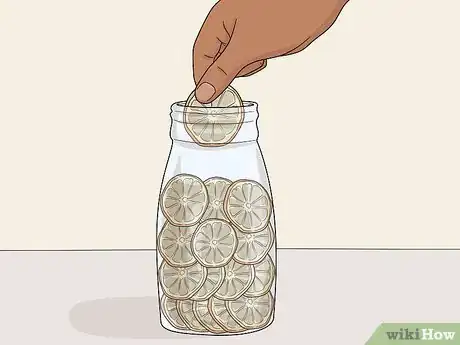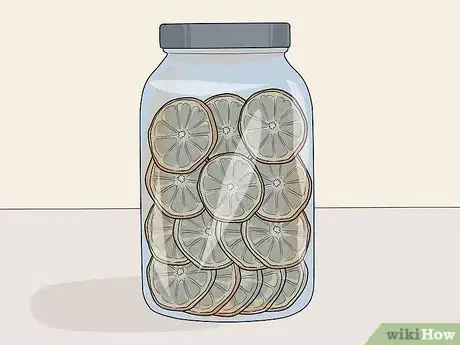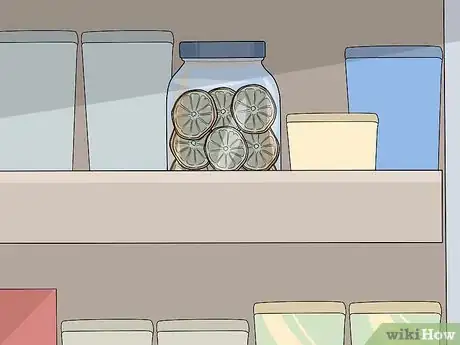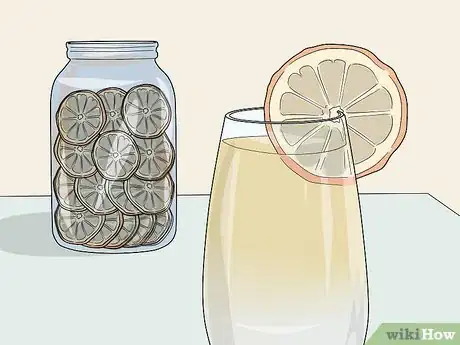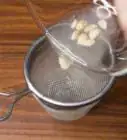This article was co-authored by wikiHow staff writer, Janice Tieperman. Janice is a professional and creative writer who has worked at wikiHow since 2019. With both a B.A. and M.A. in English from East Stroudsburg University, she has a passion for writing a wide variety of content for anyone and everyone. In her free time, you can find her working on a new crochet pattern, listening to true crime podcasts, or tackling a new creative writing project.
There are 7 references cited in this article, which can be found at the bottom of the page.
This article has been viewed 20,980 times.
Learn more...
Dehydrated citrus fruit works great as a garnish, decoration, or potpourri ingredient! To prepare your own lemons, limes, oranges, grapefruits, or other citrus foods, first wash and slice the fruit into thin pieces. Next, use a dehydrator, oven, or natural light source to completely dry out the slices. After checking the fruit for any leftover moisture, you can enjoy your citrus slices for up to 1 year!
Steps
Cleaning and Slicing the Citrus
-
1Rinse each citrus fruit under cool running water. Arrange your lemons, limes, oranges, and other citrus fruits by the sink. Next, hold each individual fruit under a stream of cool tap water. Rotate the produce slowly, using your fingers or a produce brush to remove any obvious specks of dirt or grime.[1]
- You don’t need to use any produce wash for this.
- You’ll be leaving the rinds on the fruit during the dehydration process.
-
2Dry off each fruit with a paper towel. Take a clean paper towel or cloth and wipe off any lingering water from the fruit. Blot away any visible water droplets, so the fruit isn’t especially wet when you dehydrate it.[2]
- To save time, dry off each fruit as soon as you rinse it off.
Advertisement -
3Cut your citrus fruits into ⅛ in (0.3 cm) slices. Arrange your washed fruits near a cutting board. Using thin, careful motions, slice your citrus into very thin pieces. If you see any obvious seeds, feel free to discard them.[3]
- Citrus fruits are naturally moist. If you cut them into thick pieces, then the fruit will take a long time to dry out.
Using a Dehydrator
-
1Arrange the citrus slices onto the trays in a single layer. Pull out or remove the trays from your dehydrator. Next, place each citrus slice on the tray, making sure that no slices overlap in the process. Continue filling up the dehydrator trays until you run out of room in the device.[4]
- If the fruit slices overlap, then they won’t dry out evenly.
-
2Set the temperature of your dehydrator to 140 °F (60 °C). Find the temperature controls on your device, and set the machine to a steady, even heat. Since you’re just dehydrating the fruit, don’t set the machine to anything higher than 200 °F (93 °C), or else the fruit to bake.[5]
- Double check the user manual for your dehydrator before setting the temperature. The guide might have recommended settings or temperatures for you to use!
-
3Wait at least 6-8 hours for your citrus slices to dry out. Take note of when you placed the fruit in the dehydrator before going about the rest of your day. In about 6 to 8 hours, check the fruit to see how dry it is. To check the fruit’s doneness, press your fingertip into the center of the fruit. If your finger doesn’t leave a bump or mark, then the citrus fruit is fully dry![6]
- If the fruit isn’t completely dry yet, leave the slices in the dehydrator for another 1-2 hours. At this time, test 1 of the slices to see if it’s completely dry.
-
4Remove the slices from the dehydrator to let them cool. Pull out the trays from your dehydrator so you can access the fruit. While the slices are still warm, use tongs to remove them from the dehydrator and arrange them on a cooling rack for at least 30 minutes, or until the fruit is cool to the touch. To make the cooling process more efficient, try leaving your slices in a dry area.[7]
- A kitchen countertop or table is a great place to cool your citrus slices, as long as this surface isn’t near a dishwasher or other moist area. Before placing your fruit on a bare counter, clean off the surface or lay down paper towels first.
Drying in the Oven
-
1Preheat your oven to 150 °F (66 °C). Check your owner’s manual to see how low you can set your oven. If possible, set your appliance to an extremely low temperature, so the fruit can dehydrate without baking. Unfortunately, if your oven can’t be set lower than 200 °F (93 °C), you can’t use it as a dehydrator.[8]
- While baking is a delicious alternative for your citrus slices, it won’t dehydrate them.
-
2Arrange the fruit slices on a drying tray or cooling rack. Place your citrus pieces side-by-side on an oven-safe surface. As you arrange the fruit, check that the slices aren’t overlapping, as this will interfere with the dehydrating process.[9]
- Don’t place the fruit directly on the oven racks, as this will prevent the fruit from drying evenly.
- If you’re working with a lot of citrus slices, you might need to dehydrate in batches.
-
3Place the citrus trays 2 in (5.1 cm) apart in the oven. Slide the trays into the oven, leaving a small amount of space between each rack. If you don’t have enough space between each tray of fruit, then your citrus may not dry consistently.[10]
-
4Open the oven door by at least 2 in (5.1 cm). Don’t close your oven door completely; instead, keep it open by a few inches or centimeters, so air can flow in and out of the oven. Since you’ll need to keep your oven door open for several hours, pick a time when you’ll be home so you can monitor the process.[11]
- The open door allows the oven to function more like a dehydrator.
- Use caution if you’re preparing the fruit near small children.
-
5Keep the oven door open for 8 hours as you wait for the fruit to dry. Set a timer, or a make a mental note of when you first placed the citrus slices in the oven. Since dehydrating is a slow, gradual process, you’ll need to wait at least 8 hours for your fruit to dry out, depending on the batch. To test the fruit, use a pair of tongs to remove 1 piece of fruit from the oven. Next, press your finger into the middle of a citrus slice—if you don’t see any markings or dents from your finger, then the fruit is ready to be removed from the oven![12]
- Test the fruit with caution. You don’t want to burn yourself!
- If the fruit isn’t dry, leave it in the oven for at least 1-2 hours. Check on the fruit slices periodically to see if they’re dry; however, note that it might take up to 18 hours for fruit to dehydrate in the oven.
-
6Set the citrus slices on cooling racks for at least 30 minutes. Take the trays or racks out of the oven. To expedite the cooling process, transfer the dehydrated slices to a cooling rack. Ideally, place the racks in a dry place, so the citrus slices can cool off quickly.[13]
Sun-Drying the Fruit
-
1Arrange the citrus slices on a baking sheet outside. Place your thinly sliced citrus on a flat tray, so the fruit will dry evenly. Before leaving the fruit to dry, check that none of the slices are overlapping. If you’re planning on dehydrating a lot of fruit, bring multiple baking sheets out to your deck or yard.[14]
- Sun-drying works best in hot, dry climates. Since this process can take 1-2 days, check the weather forecast ahead of time.
-
2Choose a bright, sunny place to arrange your citrus fruit. Find a place in or around your home with direct access to sunlight, like a sturdy driveway. If you don’t have a place to put your tray, assemble a sturdy drying rack that can sit in your yard or driveway. Before setting out your citrus, try waiting for the weather to reach 85 °F (29 °C).[15]
- If the humidity level is over 60%, then your fruit won’t dehydrate efficiently.
- Metallic trays or drying racks absorb sunlight, which makes the drying process more effective.
-
3Drape a large cheesecloth over the tray to protect the fruit. Cover the entire tray with a cheesecloth, then tuck the extra material underneath. Before you leave the tray alone, check that the cheesecloth is secure, so bugs and insects won’t snack on your citrus fruits.[16]
- Your fruit will still sun-dry when it’s covered with a cheesecloth.
-
4Wait at least 24 hours for the citrus slices to dehydrate completely. Keep the trays on your deck or porch for at least 1 day, depending on the weather. Check on the slices periodically by pressing on the fruit with your finger. If your touch doesn’t leave a visible mark, then the citrus is fully dehydrated![17]
- It can take up to 2 days for fruit to sun-dry. Don’t worry if the process seems to be taking a long time!
-
5Place the citrus slices in a dry area until they’re cool to the touch. If the citrus slices are still warm from the sun, arrange them on a cooling rack indoors. Keep the rack in a dry place, so the slices can cool off evenly. After 30 minutes pass, check on the fruit to see if it’s cool to the touch.[18]
Conditioning the Dried Citrus Slices
-
1Fill a container ⅔ of the way with citrus slices. Stack your fruit slices in a reusable plastic container. Don’t fill it up completely with fruit—instead, leave a gap at the top, so you can keep an eye out for condensation and moisture.[19]
- Conditioning is an extra precaution that helps ensure that the citrus slices are completely dry.
- A glass jar can also work for this process.[20]
-
2Place the covered container in a dry area. Set the lid or a piece of plastic wrap on top of the fruit so the container is loosely covered. Next, store the container in a prominent area where you can remember to check on it. Since you’re checking the dryness of the fruit slices, try placing the container in a cool and dry location as well.[21]
- Since you aren’t permanently storing the fruit yet, you don’t want to seal the lid tightly.
-
3Shake the container for 5 seconds each day. Hold the container of fruit in both hands and give it a good jostle. Continue shaking the fruit slices several times, so the citrus can move freely in the box or jar. After you’ve shaken the fruit, place the container back in a cool, dry location.[22]
- If your fruit isn’t completely dry, the shaking will eventually create moisture or condensation.
-
4Watch for signs of dew or condensation over 7 days. Look for any water droplets, dew, or other signs of condensation and moisture within the container. If you see these signs, note that your citrus slices aren’t completely dry yet. At this point, remove the slices from the container and set them aside on a cooling rack or plate.[23]
- If your fruit doesn’t show signs of moisture over this period of time, then it’s safe to assume that your citrus is completely dehydrated!
-
5Dry the fruit again if it’s still moist. Arrange the fruit slices back into your dehydrator or oven. As you did before, set the appliance to a low temperature, which allows the slices to dry out again. Depending on the appliance that you’re using, wait 6 to 8 hours before checking on the fruit slices again.[24]
- You don’t want to store dehydrated fruit that still contains moisture.
-
6Recondition the citrus slices after drying them again. Remove the fruit from the dehydrator or oven, then arrange the slices on a cooling rack. Once the fruit is cool to the touch, layer the citrus slices in a reusable container. Monitor this container over a week or so to make sure that there’s no moisture evident.[25]
- Always condition your fruit after placing it in a dryer, even if it’s for the second time.
Storing the Fruit
-
1Stack the dried fruit slices in an airtight glass jar. Arrange your fruit in a glass jar if you’re planning on preserving them for several months. Try not to use plastic bags for storage, as they’re easy for rodents to chew through. If you use a plastic container to hold your fruit slices, check first that it’s moisture and vapor resistant.[26]
- Always choose a storage container that has a tight-fitting lid. Glass jars work well for this.
- If you want to make your storage container especially airtight, try vacuum sealing it.[27]
-
2Place the packaged fruit in a cool, dry area. Store your jars or containers of dried fruit in a pantry, cellar or other dry area.[28] Before storing your jars for a long period of time, check that the area is 60 °F (16 °C) or cooler.[29]
- If the storage area is 80 °F (27 °C), then the fruit slices will only last for about 6 months.
-
3Use your citrus slices within 1 year. Write the date on a piece of masking tape or other label. Next, place this label on the jar, so you can keep track of the citrus fruit’s freshness. If you’re storing the slices in a cool, 60 °F (16 °C) area, aim to use the fruit within 12 months.[30]
Things You’ll Need
Cleaning and Slicing the Citrus
- Water
- Paper towel
- Knife
- Cutting board
Using a Dehydrator
- Food dehydrator
- Cooling rack
- Tongs
- Paper towels (optional)
Drying in the Oven
- Drying tray
- Cooling rack
- Tongs
Sun-Drying the Fruit
- Baking sheet
- Cheesecloth
- Drying rack (optional)
Conditioning the Citrus Slices
- Reusable container
Storing the Fruit
- Glass jar
- Metal can
- Masking tape or label
- Pen
- Vacuum sealer (optional)
References
- ↑ http://homeorchard.ucdavis.edu/8199.pdf
- ↑ http://homeorchard.ucdavis.edu/8199.pdf
- ↑ https://www.ag.ndsu.edu/publications/food-nutrition/food-preservation-drying-fruits
- ↑ https://extension2.missouri.edu/gh1562
- ↑ https://extension2.missouri.edu/gh1562
- ↑ https://nchfp.uga.edu/publications/uga/uga_dry_fruit.pdf
- ↑ https://nchfp.uga.edu/publications/uga/uga_dry_fruit.pdf
- ↑ https://extension2.missouri.edu/gh1562
- ↑ https://extension2.missouri.edu/gh1562
- ↑ https://www.ag.ndsu.edu/publications/food-nutrition/food-preservation-drying-fruits
- ↑ https://www.ag.ndsu.edu/publications/food-nutrition/food-preservation-drying-fruits
- ↑ https://www.ag.ndsu.edu/publications/food-nutrition/food-preservation-drying-fruits
- ↑ https://nchfp.uga.edu/publications/uga/uga_dry_fruit.pdf
- ↑ https://www.onegreenplanet.org/vegan-food/how-to-sun-dry-foods-yourself-three-methods/
- ↑ https://nchfp.uga.edu/how/dry/sun.html
- ↑ https://www.onegreenplanet.org/vegan-food/how-to-sun-dry-foods-yourself-three-methods/
- ↑ https://nchfp.uga.edu/publications/uga/uga_dry_fruit.pdf
- ↑ https://nchfp.uga.edu/publications/uga/uga_dry_fruit.pdf
- ↑ https://extension2.missouri.edu/gh1562
- ↑ https://www.ag.ndsu.edu/publications/food-nutrition/food-preservation-drying-fruits
- ↑ https://www.ag.ndsu.edu/publications/food-nutrition/food-preservation-drying-fruits
- ↑ https://www.ag.ndsu.edu/publications/food-nutrition/food-preservation-drying-fruits
- ↑ http://homeorchard.ucdavis.edu/8199.pdf
- ↑ http://homeorchard.ucdavis.edu/8199.pdf
- ↑ https://extension2.missouri.edu/gh1562
- ↑ https://nchfp.uga.edu/publications/uga/uga_dry_fruit.pdf
- ↑ https://www.epicurious.com/expert-advice/how-to-dehydrate-fruit-step-by-step-article
- ↑ https://www.ag.ndsu.edu/publications/food-nutrition/food-preservation-drying-fruits
- ↑ https://nchfp.uga.edu/publications/uga/uga_dry_fruit.pdf
- ↑ https://nchfp.uga.edu/publications/uga/uga_dry_fruit.pdf
